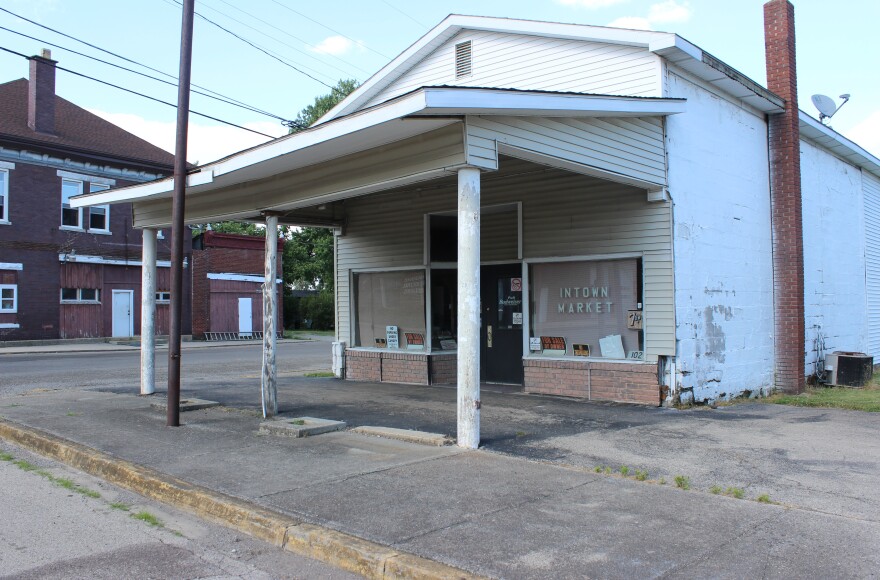The village of Woodstock is in northern Champaign County. Homes are over a hundred years old and a faded for-sale sign is posted in the window of one of the few markets. Neighbors chat on the street. Kids hang out in backyard pools. American flags and a pride flag hang from front porches.
At the center of town is the only bar. The neon Budweiser sign is turned off. It's now closed. In January of 2021 it was a very different scene. The FBI raided that bar, looking for people they say plotted the Jan. 6 attack.
Two of those suspects appear in a video as they storm the Capitol, which was then posted on Parler and obtained by ProPublica.
Donovan Crowl is charged with conspiracy and obstructing an official proceeding. Federal prosecutors say Jessica Watkins, who owned the bar, was one of the “most extreme insurgents.” Both are affiliated with the anti-government extremist group the Oath Keepers.
Crowl has been released from jail as he awaits his trial in late 2022. Jessica Watkins was indicted on an additional charge of seditious conspiracy earlier this year and remains in jail in Washington D.C.
An NPR database shows at least 48 people in Ohio were arrested in connection with the U.S Capitol attack, the sixth most in the country. Ohio also has the second most antigovernment groups, according to the Southern Poverty Law Center.
When the FBI raided the bar, Woodstock resident Edward Minor saw cars and agents swarm the building. Woodstock is usually such a safe, quiet town, he said.
“It never occurred to me that they were coming here to Woodstock because nothing ever happens here," he said. “So to find out that we had a group from here at the Capitol was totally shocking to me. It shocked a lot of people in this town."
He’s a Trump supporter, but doesn’t support the vandalism and security breaches on January 6.
“As far as them going into the office and vandalizing things, no, that's wrong. And they should be held accountable for that,” he said.

Karl Pullins lives a street over. He had an anti-Biden flag hanging in his yard up until the wind blew it down, but he’s ordered a new one. He said everybody has a right to protest, including at the Capitol.
“They’ve got a right to do that. That's the people’s buildings down there. They paid for them damn buildings,” he said. “It reflects patriotism. When somebody does something wrong, you’ve got a right to protest it.”
Charles Crusie from down the block, who’s not a fan of Trump, feels differently.
“I think they all should have been arrested, every one of them, as a terrorist,” he said. “If we'd had foreign people come over here and do that, what would we do to them?”
As for why people from here might have joined, Edward Minor has a theory.
“People from this area, some of them are very gullible. Anything new or any type of organization, ‘Well, hey, I want to be a part of that.’ But they really don't know what they're getting into.”
According to Sam Jackson of the University at Albany in New York, Minor isn’t too far off. Jackson is the author of Oath Keepers: Patriotism and the Edge of Violence in a Right-Wing Antigovernment Group, and says someone might join the Oath Keepers because a friend at a bar tells them it’s a patriotic social group.
“Only once you spend more and more time with that organization do you realize that there's a lot more extremism there, a lot more playing footsie with violence,” he said.
Recruitment also happens online. The Oath Keepers targets people with law enforcement or military backgrounds, like Army veteran Jessica Watkins. Plus, the group engages in what Jackson describes as strategic ambiguity, with broad and malleable messaging.
“Even if Oath Keepers doesn't specifically call for violence or criminality, which they do relatively rarely, they can still set the stage for others to decide for themselves that violence or criminality is necessary based on how they depict the world,” he said. “Based on the sort of breathless panic about what might happen if so-called good patriots don't stand up and take action.”

Divisive rhetoric about race and immigration can fuel that panic. Holley Hansen of Oklahoma State University says that is key to right-wing extremism.
“In fact, the fact that it is the places where they have the least amount of diversity that tend to see more violence does suggest that this is really more about the perceptions and the fears, people's personal fears, than it is about the reality of what's going on,” she said.
Hansen and Stephen Nemeth, also of Oklahoma State University, found in their research that right-wing terrorism is more often carried out in counties that are predominantly white and that have electoral competition, where divisive rhetoric can stoke personal grievances and frustrations into violence.
The Southern Poverty Law Center reports that the number of hard-right antigovernment groups has more than tripled since 2008. But Hansen notes that this movement does not reflect mainstream conservatism or the entire Republican Party.
In Woodstock, Edward Minor says people can come together by talking to their neighbors and their elected officials.
“We don't need to pick up a sword when we can pick up a pen. We can pick up a pen and write our congressmen. We could write our mayors. We could write our senators,” he said, “And then we can all come together on voting day and we can voice our opinion. That's where we're going to be loudest heard.”


